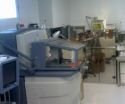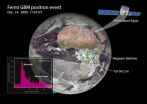(Press-News.org) Researchers at the University of Gothenburg, Sweden, have developed new methods for analysing medical databases that can be used to identify diagnostic markers more quickly and to personalise medication for allergic disorders. They could also reduce the need for animal trials in clinical studies.
Published in the journal PLoS Computational Biology, the study builds on data analyses of freely available medical databases representing studies of countless numbers of patients in the
PubMed database, and microarray data in another major database. The use of microarrays is a method that allows scientists to study all 20,000 human genes at the same time for various disorders.
Groups of researchers in Gothenburg, Oslo and Rome have developed computational methods to simulate how a change in the interaction between several different genes in the lymphocytes (a kind of white blood cell) controls the immune system. They identified the genes by reviewing abstracts of all 18 million articles included in PubMed, and then constructed a network model of how these genes interact.
"The model can be compared to a printed circuit card in the lymphocyte which the cell uses to make decisions about whether to activate or suppress the immune system," says Mikael Benson, a researcher at the Sahlgrenska Academy's Unit for Clinical Systems Biology and consultant at the Queen Silvia Children's Hospital. "These decisions are made constantly as the lymphocytes are constantly exposed to different particles, just through breathing for example. Some of the particles could be dangerous and need to trigger a decision to mobilise the immune system. However, sometimes wrong decisions are made, which can lead to various disorders such as allergy or diabetes."
The researchers then carried out data simulations of how the network model reacted to repeated exposure to particles, which resulted in four reaction patterns, one of which was to suppress the immune system, while the other three were to trigger it in various ways.
"We found that the genes in the model reacted in lymphocytes from patients with various immunological disorders. We'll be using the model to identify diagnostic markers so that we can personalise medication that we're testing in clinical studies of allergy patients."
Benson believes that these methods will become increasingly important in the future, as the huge amount of information in medical databases is growing all the time. This information could serve as an important resource for researchers in their endeavours to investigate and verify medical hypotheses.
"These methods could reduce the need for animal trials and lead to major savings in both time and money," says Benson. "They could also mean quicker and better-designed experiments and their results could generate new knowledge about diagnostic markers or new medicines."
INFORMATION:
The study comes under two EU projects, ComplexDis and MultiMod, both of which are led from the Sahlgrenska Academy. http://www.multimod-project.eu/index.html
Journal: PLoS Computational Biology
Title of article: Combining network modeling and gene expression microarray analysis to explore the dynamics of Th1 and Th2 cell regulation
Authors: Marco Pedicini Fredrik Barrenäs, Trevor Clancy, Filippo Castiglione, Eivind Hovig, Kartiek Kanduri, Daniele Santoni, Mikael Benson
New markers for allergic disorders thanks to analysis of medical databases
2011-01-12
ELSE PRESS RELEASES FROM THIS DATE:
Winter sports threaten indigenous mountain birds
2011-01-12
In the winter months, the mountain ranges of central Europe attract thousands of tourists for skiing, snowboarding and other outdoor sports, but conservationists fear this annual invasion may threaten indigenous bird species, including the Capercaillie. The research, published in the journal IBIS, reveals how the growth of human recreation may be a key factor in the rapidly declining population of these iconic alpine birds.
The Capercaillie (Tetrao urogallus), also known as the Wood Grouse, is the largest member of the grouse family and is renowned for its mating display. ...
Consumption Report 2010: Swedes' alcohol consumption is falling
2011-01-12
Swedes drink less and less alcohol while at the same time the Swedish Alcohol Retail Monopoly's sales
are rising and statistics from Statistics Sweden show that alcohol consumption is on the increase. This
has been the trend for a long period of time. Statistics from the Centre for Social Research on Alcohol
and Drugs, SoRAD, show that alcohol consumption fell continuously in the period from 2004 to 2009,
whereas the Swedish Alcohol Retail Monopoly's sales rose by 22% over the same period. The Swedish
Alcohol Retail Monopoly's sales rose by 10% from 2008 to 2009, whereas ...
Scientists explain link between chlamydia and ectopic pregnancy
2011-01-12
Women who have had chlamydia are at greater risk of an ectopic pregnancy because of a lasting effect of the infection.
A new study provides evidence for the first time of how chlamydia can increase the risk of an ectopic pregnancy – which occurs when an embryo implants outside the womb, in the Fallopian tube.
Researchers at the University of Edinburgh found that women who had had the sexually transmitted infection were more likely to produce a particular protein in their Fallopian tubes.
Increased production of this protein – known as PROKR2 – makes a pregnancy more ...
New molecular imaging technologies for detecting cellular processes
2011-01-12
The work carried out by these scientists has ranged from the initial design of an electronic architecture for gamma ray detectors to industry transfer of a complete scanner, after having adequately validated a prototype through experimental studies at the Gregorio Marañón Hospital. The results of this research, headed by professors Juan José Vaquero and Manuel Desco, from the Department of de Bioengineering and Aerospace Engineering at UC3M, have been recently published in the journals IEEE Transactions on Nuclear Science (two articles) and Physics in Medicine and Biology ...
NASA's Fermi catches thunderstorms hurling antimatter into space
2011-01-12
WASHINGTON -- Scientists using NASA's Fermi Gamma-ray Space Telescope have detected beams of antimatter produced above thunderstorms on Earth, a phenomenon never seen before.
Scientists think the antimatter particles were formed in a terrestrial gamma-ray flash (TGF), a brief burst produced inside thunderstorms and shown to be associated with lightning. It is estimated that about 500 TGFs occur daily worldwide, but most go undetected.
"These signals are the first direct evidence that thunderstorms make antimatter particle beams," said Michael Briggs, a member of Fermi's ...
Benefit of brachytherapy in patients with early-stage prostate cancer is still unclear
2011-01-12
It remains an unresolved issue as to whether interstitial brachytherapy has advantages compared to other therapy options in men with localized prostate cancer, nor do newer studies provide proof in this respect. This is the result of a report published by the Institute for Quality and Efficiency in Health Care (IQWiG) on 11 January 2011. In this report IQWiG examined whether newer studies challenged the findings of research already completed in 2007. However, it was shown that no relevant new evidence could be obtained from the recent studies. The conclusions of the final ...
Targeting nicotine receptors to treat cognitive impairments in schizophrenia
2011-01-12
Smoking is a common problem for patients with schizophrenia. The increased tendency of patients diagnosed with this disorder is to not only smoke, but to do so more heavily than the general public. This raises the possibility that nicotine may be acting as a treatment for some symptoms of schizophrenia.
Nicotine acts through two general classes of brain receptors, those with high and low affinity for nicotine. The low affinity class of nicotinic receptors contains the alpha-7 subunit, which is present in reduced numbers in people with schizophrenia.
Two papers published ...
Planck unveils wonders of the Universe
2011-01-12
The first scientific results from Europe's Planck spacecraft featuring the coldest objects in the Universe have today been released.
Astronomers at The University of Manchester's Jodrell Bank Observatory played a key role in the worldwide teams searching for an exciting variety of astronomical finds, from massive galaxy clusters to new, unidentified objects.
Ranging from within our Galaxy to the most distant reaches of space, Planck is a flagship mission of the UK Space Agency, which funds the UK's involvement in both of Planck's scientific instruments.
Astronomers ...
The Starbucks effect: Committed customers don't like logo redesigns, research finds
2011-01-12
The negative reaction to Starbucks' redesigned logo by the company's self-described most loyal customers may be attributable to the strong connection Starbucks' consumers feel toward the brand, according to research co-authored by a professor at Penn State's Smeal College of Business.
Karen Winterich, assistant professor of marketing at Smeal, and researchers Michael Walsh of West Virginia University and Vikas Mittal of Rice University recently examined how consumers react to logo redesigns. They found that consumers who are strongly committed to a brand tend to react ...
UT researcher discovers water on moon originated from comets
2011-01-12
Researchers at the University of Tennessee, Knoxville, continue to chip away at the mysterious existence of water on the moon -- this time by discovering the origin of lunar water.
Larry Taylor, a distinguished professor in the Department of Earth and Planetary Sciences, was the one last year to discover trace amounts of water on the moon. This discovery debunked beliefs held since the return of the first Apollo rocks that the moon was bone-dry.
Then, he discovered water was actually pretty abundant and ubiquitous -- enough so a human settlement on the moon is not ...

